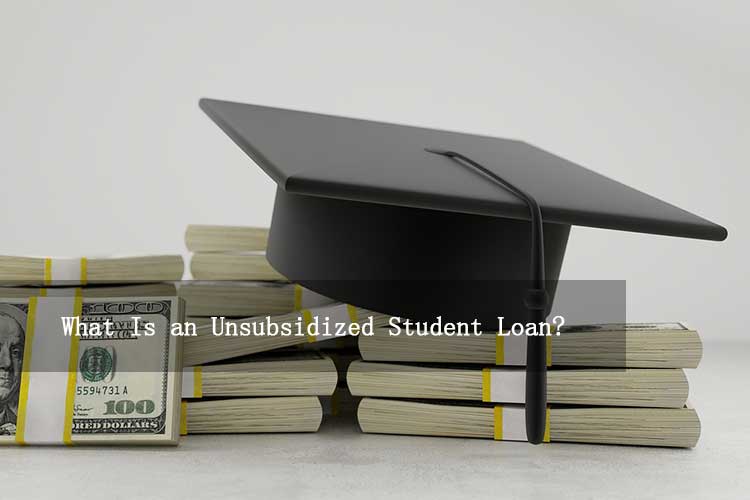
When financing a college education, student loans can be crucial in managing expenses. What Is an Unsubsidized Student Loan? A widely used option provided by the federal government is the unsubsidized student loan. Unlike subsidized loans that offer some financial assistance while you’re in school, unsubsidized loans begin accruing interest immediately, presenting a different choice for students and their families. So, what exactly is an unsubsidized student loan, and how does it function? This guide will give you all the information necessary to grasp this federal loan option.
What Is an Unsubsidized Student Loan?
What Is an Unsubsidized Student Loan? An unsubsidized student loan is a federal loan that doesn’t require proof of financial need. It’s part of the Federal Direct Loan Program and is available to both undergraduate and graduate students. One important aspect of unsubsidized loans is that interest begins to accumulate as soon as the loan is issued. Unlike subsidized loans, the federal government does not cover the interest on unsubsidized loans while you’re in school, during the grace period, or any deferment periods.
These loans are accessible to all students who meet the eligibility requirements, regardless of their financial circumstances. This broad availability makes them a convenient option, but students should be ready to handle the accumulating interest, even while they are still studying.
How Does Interest Work on Unsubsidized Loans?
Understanding how interest works on unsubsidized student loans is crucial. As soon as the loan is disbursed, interest begins to accumulate. This means that while you’re in school and not required to make payments, the interest keeps growing, which will increase the total amount you owe over time.
If you decide not to pay the interest during your studies, it will be capitalized, meaning it gets added to your loan balance when you start repayment. This can lead to a significantly higher total repayment amount over the life of the loan.
For instance, if you take out a $10,000 loan with a 5% interest rate and don’t pay the interest while studying, it will continue to accumulate throughout your time in school. If you stay in school for four years without making any interest payments, you could end up owing much more by the time you graduate, as the interest will have been added to your initial loan amount.
Eligibility for Unsubsidized Student Loans
To qualify for an unsubsidized student loan, you must meet the general eligibility requirements for federal student aid. This includes:
- Being a U.S. citizen or eligible non-citizen.
- Enrolling at least half-time in an eligible degree or certificate program.
- Maintaining satisfactory academic progress in your course of study.
- Having a valid Social Security number.
Unlike subsidized loans, there is no requirement to demonstrate financial need to qualify for an unsubsidized loan. Whether you are from a high-income or low-income family, as long as you meet the basic criteria, you can apply for this loan.
How to Apply for an Unsubsidized Student Loan
To apply for an unsubsidized student loan, you first need to fill out the Free Application for Federal Student Aid (FAFSA). After you submit your FAFSA, the financial aid office at your school will assess how much you can borrow, taking into account your cost of attendance and any other financial aid you might be receiving.
Once your eligibility for the loan is established, you’ll need to sign a Master Promissory Note (MPN). This is a legal agreement where you commit to repaying the loan according to the terms set by the Department of Education. Additionally, you’ll have to complete entrance counseling, which will help you understand your responsibilities regarding the loan and the repayment options available to you.
Loan Limits for Unsubsidized Student Loans
There are limits on how much you can borrow through unsubsidized student loans. These limits vary depending on your year in school and whether you are a dependent or independent student. For undergraduate students, the loan limits are as follows:
- First-year undergraduates: Up to $5,500, with no more than $3,500 from subsidized loans.
- Second-year undergraduates: Up to $6,500, with no more than $4,500 from subsidized loans.
- Third-year and beyond: Up to $7,500, with no more than $5,500 from subsidized loans.
Graduate and professional students can borrow up to $20,500 per year in unsubsidized loans, with no subsidized loans available.
There is also an aggregate loan limit, which is the total amount you can borrow over the course of your education. For dependent undergraduate students, the aggregate limit is $31,000, with no more than $23,000 from subsidized loans. For independent undergraduate students, the aggregate limit is $57,500. Graduate and professional students have an aggregate limit of $138,500, which includes any undergraduate loans.
Unsubsidized Student Loan Repayment Options
Repayment for unsubsidized student loans typically begins six months after you graduate, leave school, or drop below half-time enrollment. However, you can choose to start making payments on the interest while you are still in school to prevent it from being capitalized and added to your loan balance.
The Department of Education offers several repayment plans to help borrowers manage their unsubsidized student loans. These include:
- Standard Repayment Plan: Fixed monthly payments over a 10-year period.
- Graduated Repayment Plan: Payments start low and gradually increase every two years.
- Income-Driven Repayment Plans: Monthly payments are based on your income and family size, which can help reduce the burden for borrowers with lower incomes.
You can switch between repayment plans at any time to find one that fits your financial situation. It’s important to review each option carefully to choose the one that will work best for your needs.
Advantages and Disadvantages of Unsubsidized Loans
As with any financial product, there are pros and cons to unsubsidized student loans. Understanding these can help you make an informed decision about whether this loan is right for you.
Advantages:
- Available to all students, regardless of financial need.
- Higher borrowing limits compared to subsidized loans.
- Flexible repayment plans and options for deferment or forbearance.
- Access to federal loan forgiveness programs, depending on your career path and repayment plan.
Disadvantages:
- Interest starts accruing immediately upon disbursement.
- Can result in a higher overall loan balance due to capitalized interest.
- No government assistance with interest during periods of deferment.
How to Manage an Unsubsidized Student Loan
Managing an unsubsidized student loan requires planning and careful budgeting. Here are a few tips to keep your debt under control:
- Pay interest while in school: If possible, make interest payments while you are still in school. This will prevent the interest from capitalizing and adding to your loan balance.
- Choose the right repayment plan: Select a repayment plan that fits your financial situation, and consider income-driven plans if your income is low after graduation.
- Consider extra payments: If your budget allows, making extra payments on your loan can help you pay off the loan faster and reduce the total interest paid over time.
Conclusion
Unsubsidized student loans are a great financial resource for those seeking higher education. They offer flexibility and are easy to access, but it’s important to remember that interest starts accumulating right after the loan is issued. What Is an Unsubsidized Student Loan? By familiarizing yourself with the essential aspects of unsubsidized student loans—such as eligibility criteria, loan limits, and repayment choices—you can make informed decisions that will benefit both your education and your financial situation.



